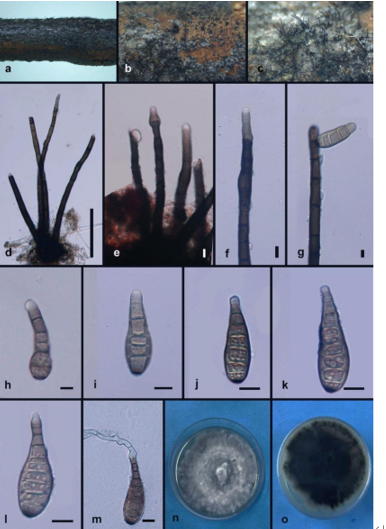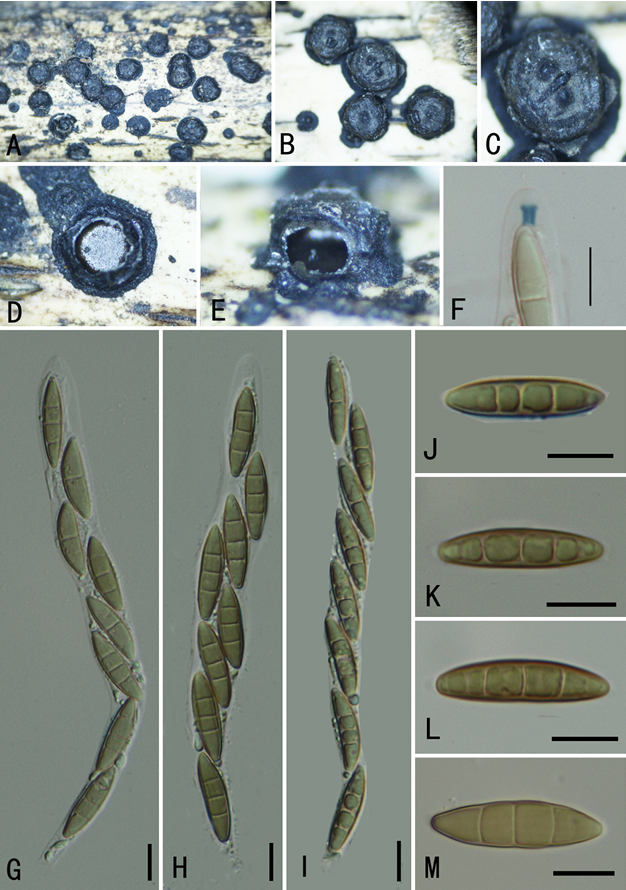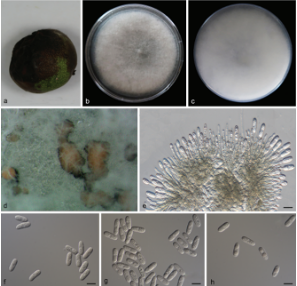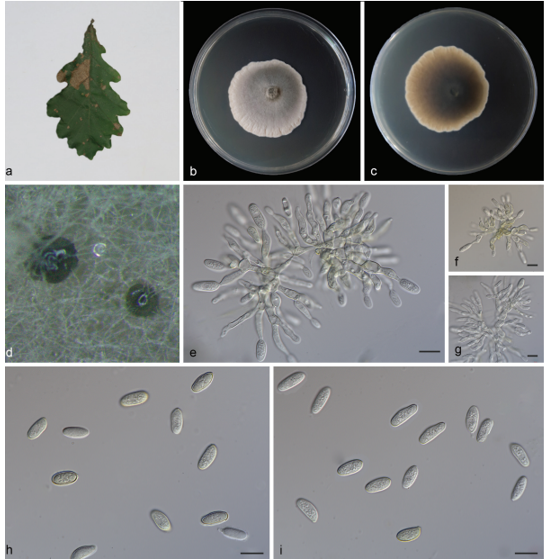Ophiostoma lotiforme Z. Wang & Q. Lu 2020
MycoBank MB 830612
Holotype: China: Inner Mongolia Autonomous Region, Hailar, from Ips subelongatus on Pinus sylvestris var. mongolica, Aug. 2010, X. Meng (CXY 2017 – holotype, CFCC 52691 = MUCL 55165 – ex-type culture).
Morphological description
Sexual morph: not observed. Asexual morphs: pesotum-like and hyalorhinocladiellalike. Pesotum-like morph: synnemata occurring in groups, the base hyaline, (78.5–) 81.5–91.5 (− 94) μm wide, (876–) 945–1224 (− 1290) μm tall including the conidiogenous apparatus. Conidiogenous cells (12–) 15–23 (− 28.5) × (1.5–) 2–2.5 μm. Conidia hyaline, smooth, clavate to ovate, aseptate, 4–5.5 (− 6) × 2–2.5 μm; compound, lotus–shaped, pesotum-like conidiomata, pure white, (898–) 971–1296 (− 1450) μm wide at base, (964–) 1019–1427 (− 1655) μm tall. Hyalorhinocladiella-like morph: conidiogenous cells arising from superficial hyphae, (6–) 11–22 (− 28.5) × 1.5–2.5 (− 3) μm. Conidia hyaline, aseptate, smooth, clavate to ovate, (3.5–) 4–5.5 (− 6.5) × (2–) 2.5–3.5 (− 4) μm. Cultures: Colonies on 2% MEA at 25 °C reaching 65mm diam. in 15 d, pure white, the colonies margin smooth; mycelium superficial on the agar. Optimal temperature for growth at 30 °C, no growth observed at 5 °C and 40 °C.
Habitat: Mixed forest of P. sylvestris var. mongolica and L. gmelinii.
Ecology: Isolated from Ips subelongatus infesting dying Pinus sylvestris var. mongolica.
Distribution: Inner Mongolia Autonomous Region, China.
GenBank Accession: ITS/LSU MK748185; β-tubulin gene MN896044
Notes: The compound, lotus-shaped conidiomata are unique, and its synnemata are distinctly taller than those of the related species O. saponiodorum, respectively (876–) 945–1224 (− 1290) μm vs. (118–) 188–297 (− 370) μm. Synnemata are absent in O. pallidulum (Linnakoski et al. 2010). Ophiostoma lotiforme also grows slower than O. saponiodorum on 2% MEA. In addition, no growth of O. saponiodorum is observed at 35 °C, but O. lotiforme grows at 35 °C; no growth of O. lotiforme is observed at 40 °C, but O. pallidulum grows at 40 °C.
Reference: Wang Z, Liu Y, Wang HM et al. (2020) Ophiostomatoid fungi associated with Ips subelongatus, including eight new species from northeastern China
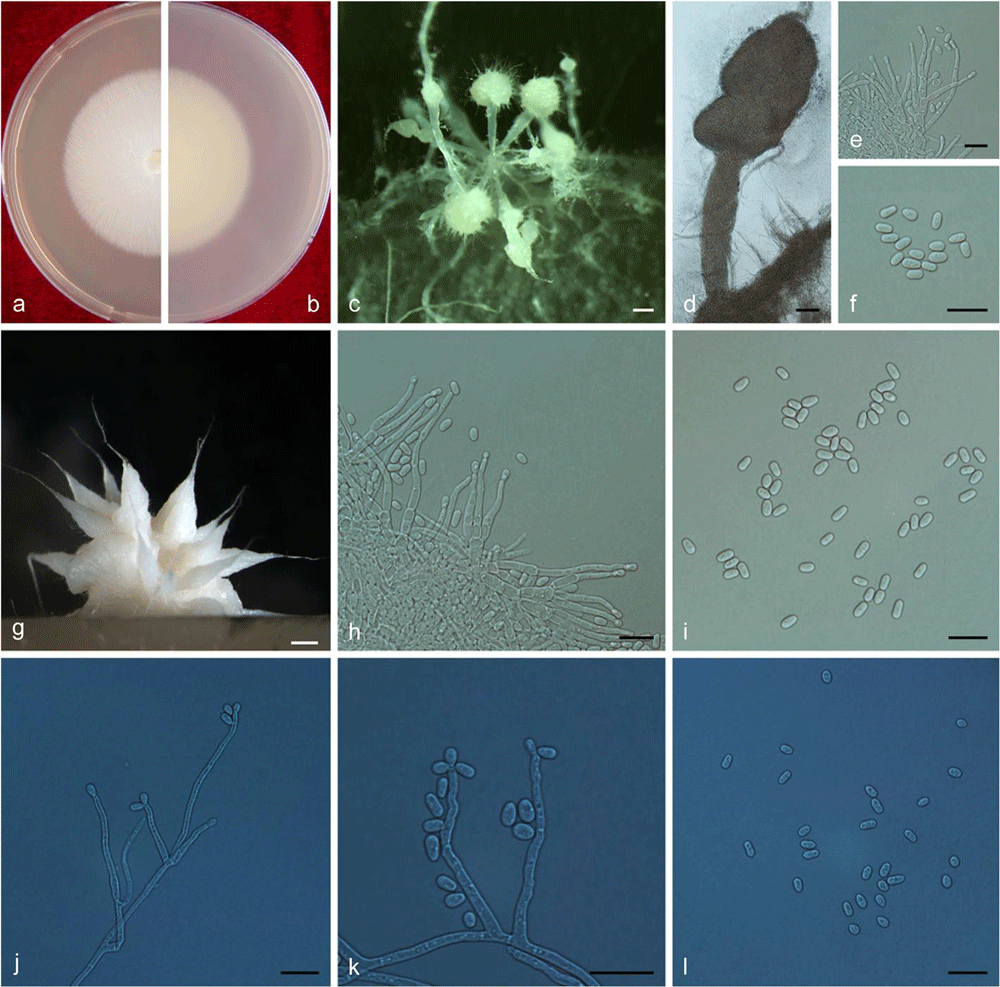
Ophiostoma lotiforme. Morphological characteristics of O. lotiforme (CFCC 52691). a–b. Fifteen-day-old cultures on 2% MEA; c–d. Pesotum-like asexual morph; e–f. Conidiogenous cells of pesotum-like asexual morph and conidia; g. Lotus-shaped conidiomata; h–i. Conidiogenous cells of lotus-shaped conidiomata and conidia; j–l. Hyalorhinocladiella-like asexual morph: conidiogenous cells and conidia. Scale bars: c = 200 μm; d = 100 μm; e–f = 10 μm, g = 200 μm; h–l = 10 μm


